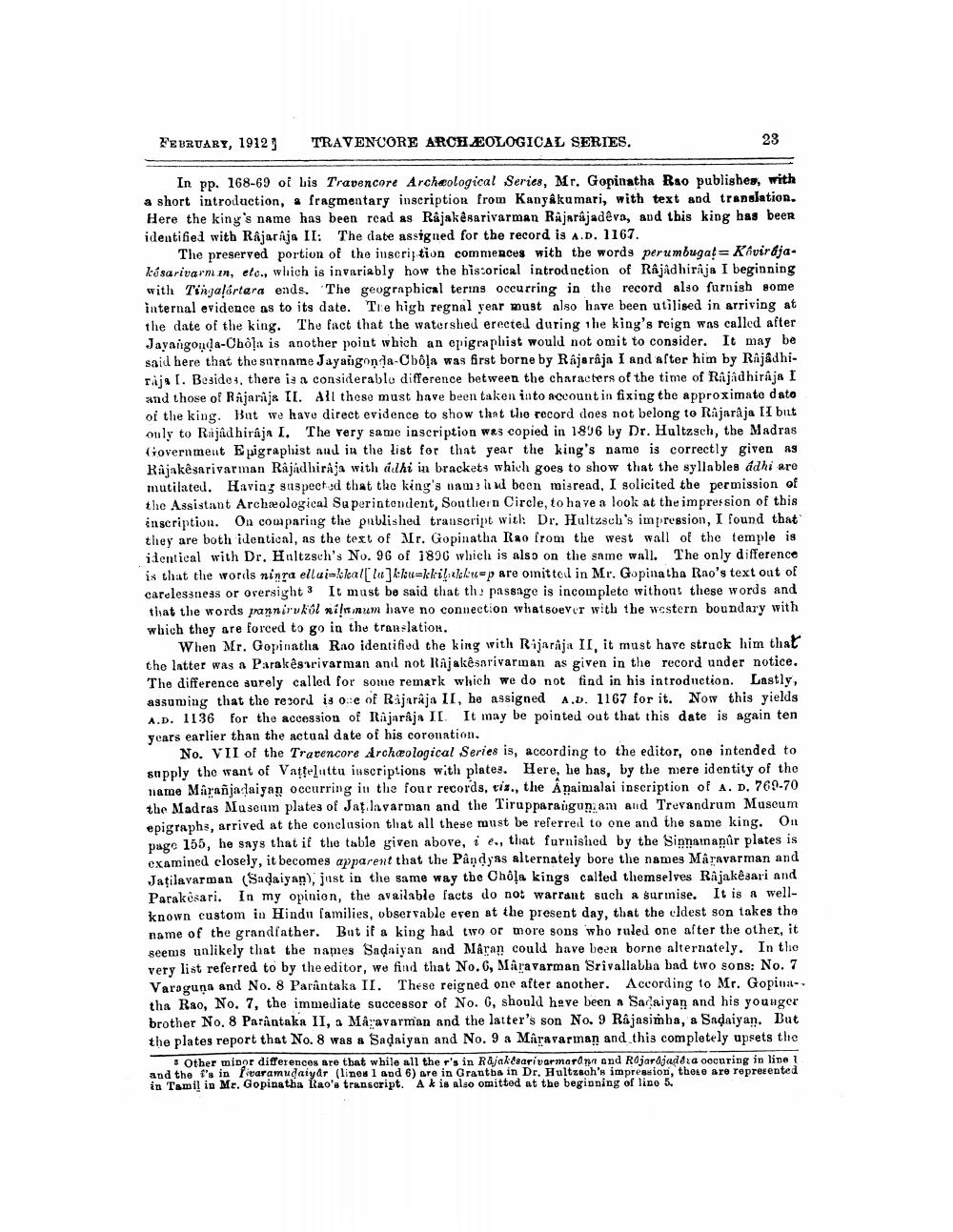________________
FEVRUARY, 1912)
TRAVENCORE ARCHAEOLOGICAL SERIES.
23
In pp. 168-69 of bis Travencore Archeological Series, Mr. Gopinatha Rao publishes, with a short introduction, a fragmentary inscription from Kanyakumari, with text and translation. Here the king's name has been read as Rajakesarivarman Rajarajadêva, and this king has beer identified with Rajaraja II: The date assigned for the record is A.D. 1167.
The preserved portion of the inscription commences with the words perumbuga!= Kaviraja. kósarivarma, eto., which is invariably how the historical introduction of Rajadhiraja I beginning with Tingalártara ends. The geographical tering occurring in the record also furnish some internal evidence as to its date. The high regnal year must also have been utilised in arriving at the date of the king. The fact that the watershed erected during the king's reign was called after Jayangoyda-Chồa is another point which an epigraphist would not omit to consider. It may be said here that the surname Jayangona-Cbôļa was first borne by Rajaraja I and after him by Rajadhirija I. Besides, there is a considerablo difference between the characters of the time of Rajadhiraja I and those of Rajaraja Il. All these must have been taken into account in fixing the approximate dato of the king. But we have direct evidence to show that the record does not belong to Rajaraja II but only to Rajadhirajn I. The very same inscription was copied in 1896 by Dr. Hultzsch, the Madras Government Epigraphist and in the list for that year the king's name is correctly given A9 Rajakesarivarman Rajadhiraja with delhi in brackets which goes to show that the syllables adhi are mutilated. Having suspected that the king's nam: lud been misread, I solicited the permission of the Assistant Archaeological Superintendent, Southern Circle, to have a look at the impression of this inscription. On comparing the published transcript witl: Dr. Haltzsch's impression, I found that they are both identical, as the text of Mr. Gopinatha Rao from the west wall of the temple is identical with Dr. Holtzsch's No. 96 of 1896 which is also on the same wall. The only difference is that the woris ninra elluinklal[la] klurkkilukkup are omittel in Mr. Gopinatha Rao's text out of carelessness or oversight It must be said that the passage is incomplete without these words and that the words prannirukol ninnum have no connection whatsoever with the western boundary with which they are forced to go in the translation.
When Mr. Gopinatha Rao identified the king with Rajaraja II, it must have struck him that the latter was a Parak@grrivarman and not Rajakesarivarman as given in the record under notice. The difference surely called for some remærk which we do not find in his introduction. Lastly, assuming that the resort is o.e of Rijarâja II, he assigned A.D. 1167 for it. Now this yields A.D. 1136 for the accession of Rajaraja II. It may be pointed out that this date is again ten years earlier than the actual date of his coronation,
No. VII of the Travencore Archæological Series is, according to the editor, one intended to supply the want of Vatteluttu inscriptions with plates. Here, he has, by the mere identity of the name Marañjadaiyan occurring in the four records, tiz., the Anaimalai inscription of A. D. 760-70 the Madras Museum plates of Jaț la varman and the Tirupparaigum am and Trevandrum Museum epigraphs, arrived at the conclusion that all these must be referrel to one and the same king. On page 155, he says that if the table given above, i e., that furnished by the Sinnamanûr plates is examined closely, it becomes apparent that the Pandyas alternately bore the names Maravarman and Jațilavarman (Sadaiyan), just in the same way the Chôļa kings called themselves Rajakesari and Parakosari. In my opinion, the available facts do not warrant such a surnise. It is a wellknown custom in Hindu families, observable even at the present day, that the eldest son takes the name of the grandiather. But if a king had two or more sons who ruled one after the other, it seems unlikely that the names Sadniyan and Maran could have been borne alternately. In the very list referred to by the editor, we find that No. 6, Mâravarman Srivallabha bad two sons: No. 7 Varaguna and No. 8 Parantaka II. These reigned one after another. According to Mr. Gopina. tha Rao, No. 7, the immediate successor of No. 6, should heve been a Sadaiyan and his younger brother No. 8 Parantaka II, a Mazavarman and the latter's son No. 9 Rajasimba, a Sndaiyan. But the plates report that No. 8 was a Sadaiyan and No. 9 a Maravarman and this completely upsets the
3 Other mipor differences are that while all the r's in R&jak darivarmar and Rojarajaddia oocuring in line ! and the train livaramudaiyar (linew land 6) are in Grantba in Dr. Hultraoh's impression, there are represented in Tamil in Mr. Gopinatha Rao's transcript.A kis also omitted at the beginning of lino 5.




